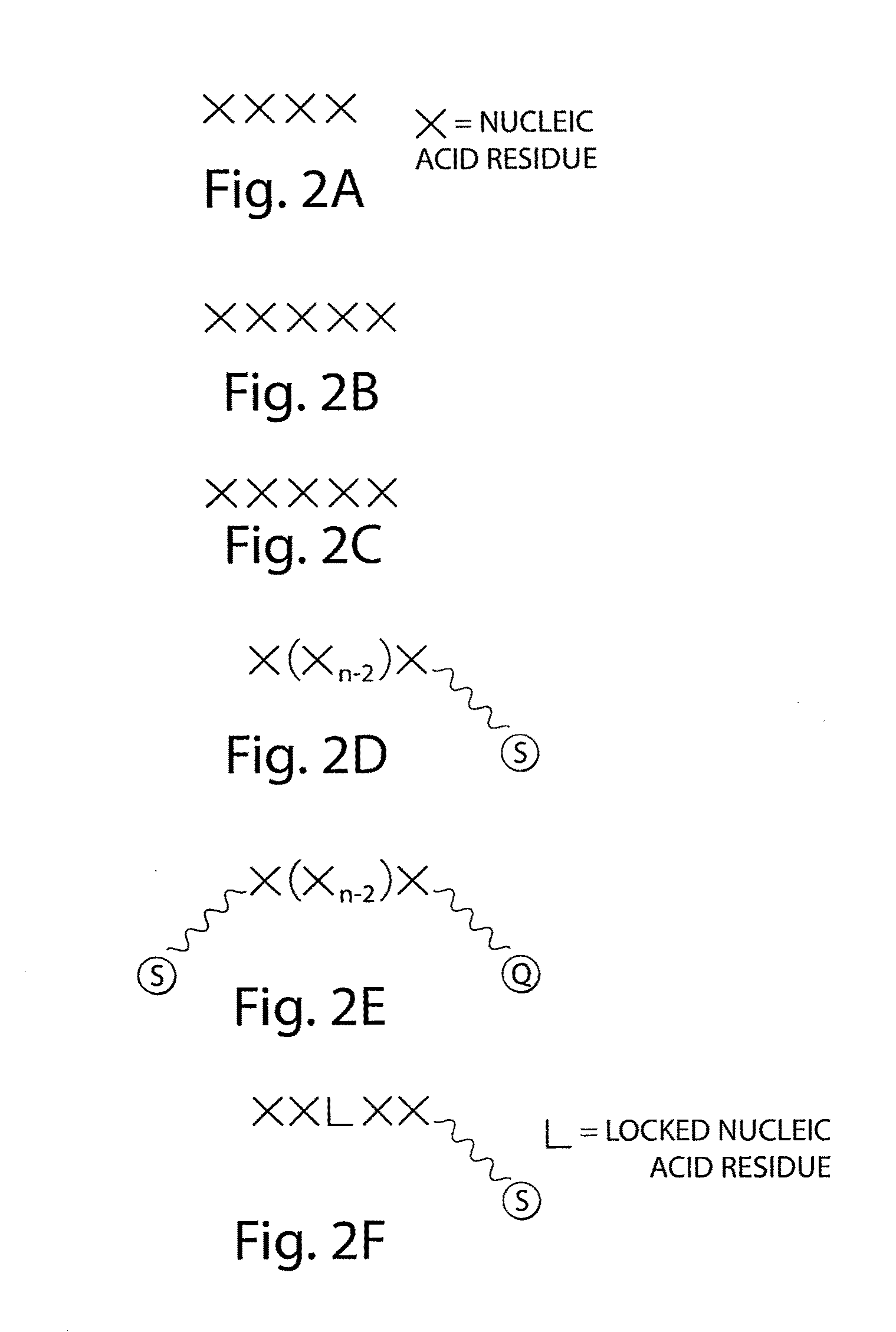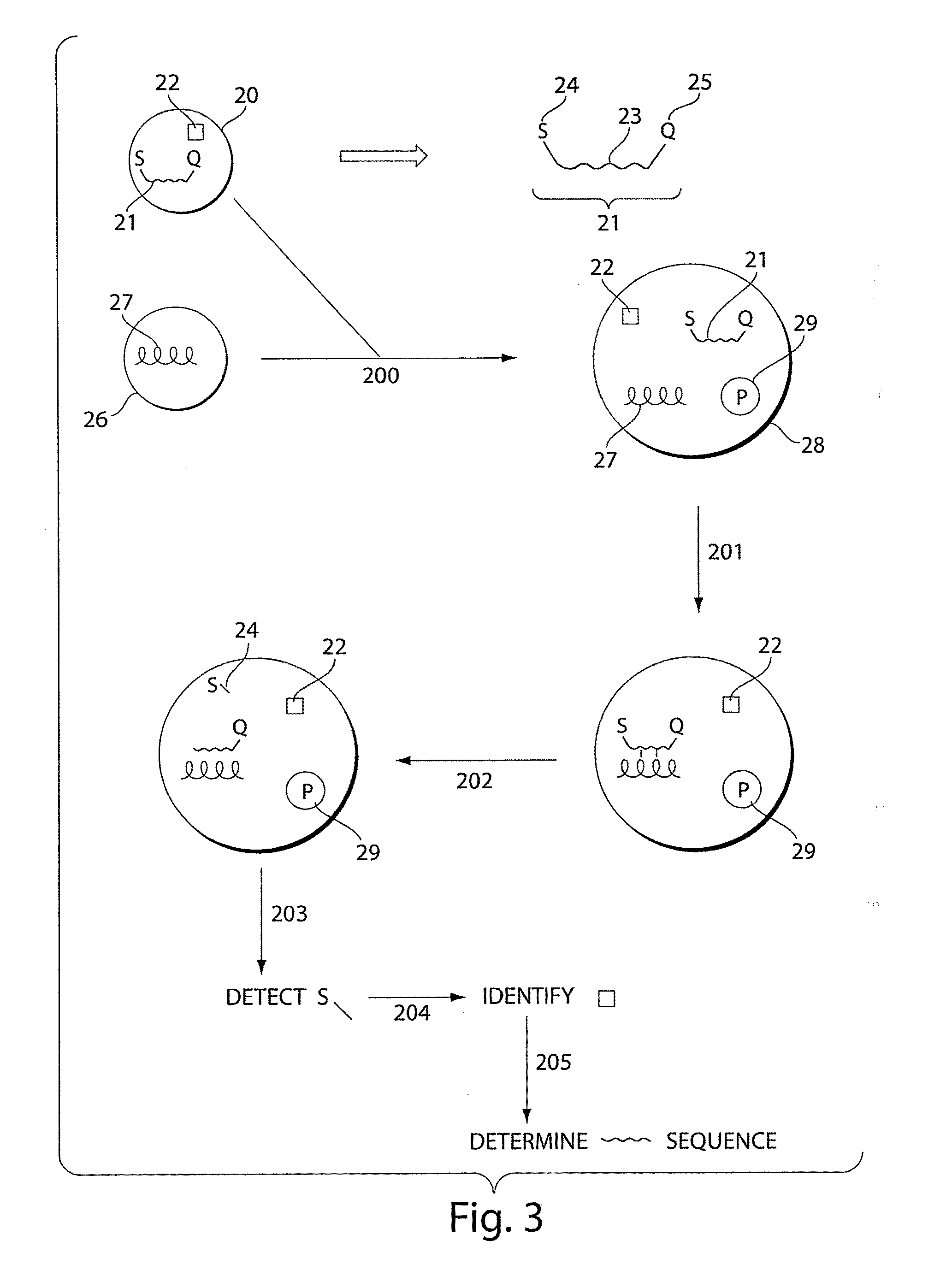Systems and methods for nucleic acid sequencing
a nucleic acid and system technology, applied in the field of systems and methods for sequencing nucleic acids, can solve the problems of limiting the application of sbh techniques, requiring relatively large quantities of reagents, and requiring current sbh techniques
- Summary
- Abstract
- Description
- Claims
- Application Information
AI Technical Summary
Benefits of technology
Problems solved by technology
Method used
Image
Examples
example 1
[0164]Non-limiting examples of methods for DNA sequencing are described in the following prophetic examples. The figures are illustrated using pentamers for illustrative purposes only. Other lengths may also be used. In addition, modified residues such as locked nucleic acid residues, and / or universal residues may also be used in some cases.
[0165]An example method is discussed with reference to FIG. 6. Specifically, this method is an example using a bead-based labeling strategy, modified nucleotides, and fluorescence. FIG. 6A shows a plurality of color-coded beads used as identification elements, for instance, beads such as those made by Luminex Corporation. The beads in this example are 5 μm diameter beads that can be divided into 100 distinguishable types (150), for instance, based on the fluorescence intensity of two distinct dyes. These beads are arbitrarily numbered 1-100.
[0166]The beads may be used for identification as follows. 40 of these distinguishable beads can be divided...
example 2
[0169]This example employs a bead-based labeling strategy, a Taqman probe, and fluorescence. As in Example 1, the droplets have a single member taken from each of four sets of identification element bead-types. FIG. 7A shows an example of the possible components in one droplet 171, as given in FIG. 6. Taqman analysis will be used in the droplets in this example.
[0170]Nucleic acid probe 169 comprises oligonucleotide 174, signaling entity 172, and quencher 173, which reduces (or enhances) fluorescence from signaling entity 172 by the use of Fluorescence (or Förster) Resonance Energy Transfer (FRET), which is the inhibition of one dye caused by another without emission of a photon. The signaling entity in this particular example is found on the 5′ end of the oligonucleotide and the quencher at the 3′ end.
[0171]The Taqman probe anneals to a target nucleic acid, as shown by 175 in FIG. 7B. Taq polymerase then adds nucleotides until it gets to the Taqman probe as shown by 176. Non-complem...
example 3
[0173]This particular example employs DNA ligation, bead-labeling and fluorescence. Luminex Corporation provides beads that can be separated into 100 distinguishable beads 210, as shown in FIG. 8A. Each bead type can be coated with a reagent specific to a particular bioassay, allowing the capture and detection of specific analytes from a sample. Lasers excite the internal dyes that identify each bead particle, and also any reporter dye captured during the assay.
[0174]FIGS. 8B and 8C illustrate the following: forty beads are divided into four groups of 10 distinguishable beads each, and each bead will have attached primers such that the first set of 10 beads will have an “A”-type set and various universal residues 214 (i.e. beads 1-10 will each have attached to them the oligonucleotide probe-set 5′-ANNNN-3′), the second set of 10 bead-types (i.e., beads 11-20) will have a “C”-type oligonucleotide 213 attached to them (i.e. 5′-CNNNN-3′), the third set of 10 bead-types (i.e., beads 21-...
PUM
| Property | Measurement | Unit |
|---|---|---|
| average diameter | aaaaa | aaaaa |
| average diameter | aaaaa | aaaaa |
| average diameter | aaaaa | aaaaa |
Abstract
Description
Claims
Application Information
 Login to View More
Login to View More - R&D
- Intellectual Property
- Life Sciences
- Materials
- Tech Scout
- Unparalleled Data Quality
- Higher Quality Content
- 60% Fewer Hallucinations
Browse by: Latest US Patents, China's latest patents, Technical Efficacy Thesaurus, Application Domain, Technology Topic, Popular Technical Reports.
© 2025 PatSnap. All rights reserved.Legal|Privacy policy|Modern Slavery Act Transparency Statement|Sitemap|About US| Contact US: help@patsnap.com



